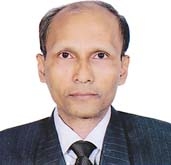
Masum Billah :
Finance Minister AHM Mustafa Kamal placed a proposed budget of Tk 603,681 crore for FY 2021-22 in the national parliament on June 3. This is the fifteenth budget in the independent Bangladesh and we had an expectation that it would be a little bit different from the traditional budget presented so far as Coronan pandemic has engulfed the entire globe in general and education and health in particular. And education is the worst suffering sector in Bangladesh. More than ten lakh teachers have not been receiving any salary or benefit who pass their days in miserable condition. Many educational institutions have forcibly been closed and many are waiting to be closed. But no direction or any positive indication has surfaced in the budget ignoring loss in this sector. On the other hand, private universities see their establishment on political considerations as business magnets or politically powerful men work behind those have very little commitment to disseminate quality education rather than making them business centers with some exceptions. The country now witnesses 148 private universities. The budget says 15 percent taxes on the income of private universities and medical colleges that now gives completely a business colour that we must not entertain.
This financial year (2021-2022) sees Tk 26 thousnad 311 crore for primary and mass education sector which was 24 thousnad 937 crore in the last financial year. In the secondary and higher education 36 thousand 48 crore has been allotted and this figue was 33 thousnad 118 crore last year. In the madrasa and technical education the budgetary allocation stands at Tk 9 thousand 154 crore which was 8 thousand 345crore taka in the last financial year. In the primary level development expenditure has been considered as Tk 8 thousand 22 crore and the rest for operation, in the secondary and higher education level development sector will get Tk 14thousand 320 crore and the rest as operating expenditure. In the technical education 2 thousand 310 crore taka will be kept as development expenditure and the rest as operationg cost. Every year two-third of the expenditure goes to salary and benefit sector of the teachers and staff and that must be a useful step as we cannot expect them to serve without having salary and benefit.
Now the development sector means professional and infrastructural development of the institutions. Training is one of the most significant areas of professional development. Teachers need subject based training, pedagogical training and management training. These trainings are going on for ages and TTCs, NAEM, different government projects and non-government sectors also provide training to the teachers. These trainings just show the philosophy of ‘spending money as the budget allows’ whether the trainings have become helpful or not, who really need training, how to select the teachers — all these are not considered. Just spend the budget on training. We know the newly appointed teachers in the colleges and secondary schools enter into the classroom almost like students as they don’t have foundation training. They need to know how to deal with a big classroom, how to effectively deal with roudy students, effective teaching-learning process, pedagogical knowledge and how to develop and why to develop rapport with the learners. Moreover, training usually takes place in the TTCs or NAEM or different RRCs or NGO run training centers. All these venues accommodate quite different scenario from those the teachers use in their own classroom. So, some training needs to be conducted in the real classroom situation.
Child marriage and the tendency to dropout have spiked and child laborers also. To address these issues at least 15 percent allocation of the budget should have been diverted to these issues. A commission formed by UNESCO, of course, proposes to spend 25 percent of the foreign aid for education and Bangladesh should conform to it. A plan ranging from two to three years need to be developed for addressing the damaged issues of education? Several pragmatic steps need to be taken to redress the gap the learners have already experienced due to Cornona. However, our budget for education revolves round the figure around 12 percent of our national budget and 2 percent GDP. Per head allocation for health and education is 5 dollar in Bangladesh which is 14 dollar in India, 150 dollar in Malaysia and 160 dollar in South Korea. Teacher student ratio need to be kept within an accepted and reasonable limit that is 1:30 in primary, lower secondary, secondary and higher secondary it should be 1:40 and in higher education it should not be more than 1:25. In the budget nothing of these phenomena mentioned or reflected, in any way.
Tk 200 crore has been allocated for non-government schools, colleges, madrasa and Ebtedai teachers and in the revised budget (2020-2021) Tk 40 crore has been sanctioned for the non-government teachers’ retirement benefit and for building and renovating residential halls of universities Tk 50 crore has been kept. Even though these amounts prove less than the necessity, we appreciate the step. Budget has been kept for brining non-government schools under MPO. Giving MPO to non-government schools brings balance to the distribution of national economy as the poor and low income and particularly rural teachers and students are the beneficiaries of this step. It always irks us that Biman, Railway, BTMC, CJMC and such and such kind of state-run organizations show millions of dollar loss every year. What is their output? What benefit they bring for the country? The government rears those collecting taxes from the poor and low income people. We don’t find any justification to rear them year after year at the cost of increasing tax and putting common people into financial trouble. Whereas, the non-government organizations see less corruption and better service that we badly need.
(Masum Billah is President, English Teachers’ Associaiton of Bangaldesh. Email: [email protected] )

